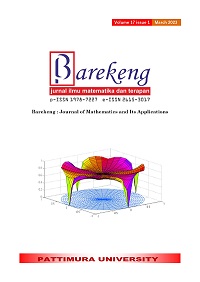APPLICATION OF THE BACKPROPAGATION METHOD TO PREDICT RAINFALL IN NORTH SUMATRA PROVINCE
Abstract
Natural disasters are to blame for the high level of community loss. This is due to the community's lack of information about potential disasters around them. As a result, public understanding of disaster response is extremely low. As a result, weather information is critical for the smooth operation of human activities and activities, such as determining the amount of rainfall. The goal of this research is to identify the best model for predicting rainfall in North Sumatra Province and to forecast rainfall trends for the coming year. The rainfall time series data used in this study were collected from six stations in North Sumatra Province over the last ten years, including the Sibolga Meteorological Station, Aek Godang Meteorological Station, and Silangit Meteorological Station. Backpropagation is used in this study. Backpropagation is one of the methods used in artificial neural networks, which are usually divided into three layers: an input layer, a hidden layer, and an output layer connected by weights. During the training stage, the learning rate, iteration, and number of nodes in the hidden layer were all tested. Following the training process, the best model will be used for testing. The best model was obtained using rainfall data from North Sumatra Province, with an optimal iteration of 1000 iterations, an optimal learning rate of 0.1 in the learning rate trial, and the best number of hidden 5 nodes. During the testing, the MSE values were 0.047 and 0.022, respectively, and the MSE squared value was 0.0022 and 0.00049.
Downloads
References
B. Prasetyo, H. Irwandi, and N. Pusparini, “Karakteristik Curah Hujan Berdasarkan Ragam Topografi Di Sumatera Utara,” J. Sains Teknol. Modif. Cuaca, vol. 19, no. 1, p. 11, 2018, doi: 10.29122/jstmc.v19i1.2787.
I. Gustari, “Pantai Barat Sumatera Bagian Utara,” J. Meteorol. Dan Geofis., pp. 29–38, 2007.
R. Rahmad, S. Suib, and A. Nurman, “Aplikasi SIG Untuk Pemetaan Tingkat Ancaman Longsor Di Kecamatan Sibolangit, Kabupaten Deli Serdang, Sumatera Utara,” Maj. Geogr. Indones., vol. 32, no. 1, p. 1, 2018, doi: 10.22146/mgi.31882.
Z. Julisman and Erlin, “Prediksi Tingkat Curah Hujan di Kota Pekanbaru menggunakan Logika Fuzzy Mamdani,” J. SATIN - Sains dan Teknol. Inf., vol. 3, no. 1, pp. 65–72, 2014.
Dynes Rizky Navianti, I Gusti Ngurah Ray, Farida Agustini W, “Penerapan Fuzzy Inference System Pada Prediksi Curah Hujan di Surabaya Utara,” J. Sains dan Seni ITS, vol. I, no. 1, p. I, 2012.
A. Roy and A. M. Hendriyawan, “Implementasi Metode Naive Bayes Classifier Untuk Perkitaan Cuaca,” p. 12, 2019, [Online]. Available: http://eprints.uty.ac.id/2916/.
R. J. Yuniar, D. R. S., and O. Setyawati, “Perbaikan Metode Prakiraan Cuaca Bandara Abdulrahman Saleh Dengan Algoritma Neural Network Backpropagation,” J. EECCIS, vol. 7, no. 1, p. pp.65-70, 2013.
P. N. L. Raja and S. Sinurat, “Implementasi Metode Backpropagation Untuk Memprediksi Penjualan Furniture Pada Pt . Indah Jaya Medan, " Majalah Ilmiah INTI, vol. 13, pp. 146–151, 2018.
D. Ruswanti, “Pengukuran Performa Support Vector Machine Dan Neural Netwok Dalam Meramalkan Tingkat Curah Hujan,” Gaung Informatika, vol. 13, no. mm, pp. 66–75, 2020.
W. R. A. Situmorang and M. Jannah, “Implementasi Jaringan Syaraf Tiruan Memprediksi Hasil Panen Padi Pada Desa Pagar Jati Dengan Metode Backpropagation,” Jurnal Ilmu Komputer dan Sistem Informasi, vol. 3, no. 3, pp. 167–175, 2021.
P. Antwi et al., “Estimation of biogas and methane yields in an UASB treating potato starch processing wastewater with backpropagation artificial neural network,” Bioresour. Technol., vol. 228, pp. 106–115, 2017, doi: 10.1016/j.biortech.2016.12.045.
R. Novita, A. Putri, P. Studi, and S. Informasi, “Analisis Algoritma Backpropagation Neural Network dalam Permalan Jumlah Benih Ikan,” Jurnal Ilmiah Rekayasa dan Manajemen Sistem Informasi, vol. 7, no. 2, pp. 201–207, 2021.
D. Susilokarti, S. S. Arif, S. Susanto, and L. Sutiarso, “Studi Komparasi Prediksi Curah Hujan Metode Fast Fourier Transformation (Fft), Autoregressive Integrated Moving Average (Arima) Dan Artificial Neural Network (Ann),” J. Agritech, vol. 35, no. 02, p. 241, 2015, doi: 10.22146/agritech.9412.
D. Jauhari, Al. Hinawan, and D. Candra, “ Jurnal Teknologi Informasi dan Ilmu Komputer, Volume 3 | Nomor | 2016 | Halaman -,” vol. 3, pp. 3–6, 2016.
B. B. Wiko Putra, M. A. Albar, and B. Irmawati, “Penerapan Algoritma Jaringan Saraf Tiruan Metode Backpropagation untuk Memprediksi Jumlah Nilai Ekspor di Provinsi NTB,” J. Teknol. Informasi, Komputer, dan Apl. (JTIKA ), vol. 1, no. 2, 2019, doi: 10.29303/jtika.v1i2.50.
I. Loelianto, M. S. S. Thayf, and H. Angriani, “Implementasi Teori Naive Bayes Dalam Klasifikasi Calon Mahasiswa Baru Stmik Kharisma Makassar,” SINTECH (Science Inf. Technol. J., vol. 3, no. 2, pp. 110–117, 2020, doi: 10.31598/sintechjournal.v3i2.651.
Copyright (c) 2023 Rinjani Cyra Nabila, Arnita Arnita, Amanda Fitria, Nita Suryani

This work is licensed under a Creative Commons Attribution-ShareAlike 4.0 International License.
Authors who publish with this Journal agree to the following terms:
- Author retain copyright and grant the journal right of first publication with the work simultaneously licensed under a creative commons attribution license that allow others to share the work within an acknowledgement of the work’s authorship and initial publication of this journal.
- Authors are able to enter into separate, additional contractual arrangement for the non-exclusive distribution of the journal’s published version of the work (e.g. acknowledgement of its initial publication in this journal).
- Authors are permitted and encouraged to post their work online (e.g. in institutional repositories or on their websites) prior to and during the submission process, as it can lead to productive exchanges, as well as earlier and greater citation of published works.






1.gif)



